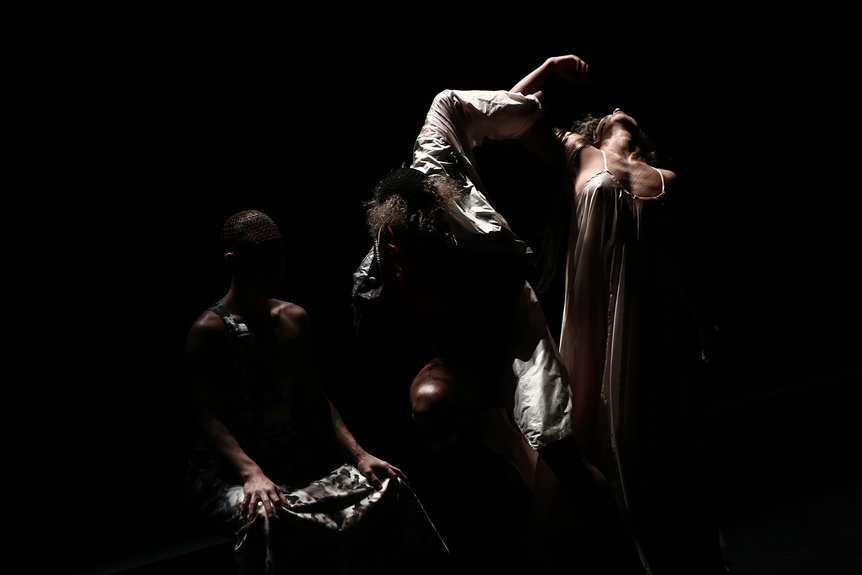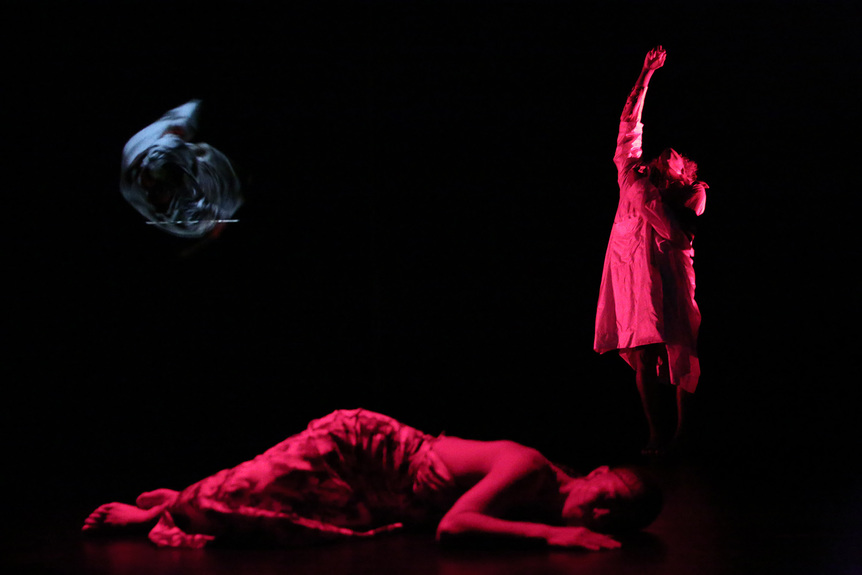
R
E
V N
E
X
T
WU TSANG and BOYCHILD, Sudden Rise, 2019, documentation of performance at the Whitney Museum of American Art, New York, 2019. Photo by Mick Bello. All images courtesy the Experimental Media and Performing Arts Center, New York.
Before stage lights illuminated the Whitney Museum’s Susan and John Hess Family Theater, the plucking of cello strings could be heard in the darkened room. The solo gave way to a beat drop, perfectly timed to coincide with a sequence of images that flashed on screen. The video revealed a quick succession of works associated with Western art history and literary canon, everything from an oil painting of Adam and Eve to a portrait of William Shakespeare. As time progressed, the images were intercut with those of iconic Black Americans, including a likeness of Harriet Tubman printed on US currency and a cropped, black-and-white photograph of James Baldwin’s recognizably large and somber eyes. Artist Wu Tsang, appearing center stage in a one-shoulder gown, later echoed this imagery through words: “You can trace the genealogy of Baldwin’s eyes.”
In Sudden Rise, Tsang, a MacArthur “genius” grant recipient, gestures to the legacy of other 20th-century writers and intellectuals, including WEB Du Bois, Langston Hughes and Hannah Arendt. The artist co-wrote the text Sudden Rise at a Given Tune, for which the piece is named, with poet Fred Moten. Delivered by Tsang in a hushed, contemplative voice, the spoken excerpts served as a loose narrative to choreographed movement performed by her partner boychild and dancer Josh Johnson. Live cello and piano by composer Patrick Belaga and loops by electronic musician Asma Maroof provided accompaniment. Along with lighting designer Alena Samoray, the ensemble collectively known as Moved by the Motion interweave a multitude of elements—poetry, dance, music and film—into the collaborative work.
Just under an hour long, the piece opened in New York City the same evening protestors staged a musical demonstration dedicated to Puerto Rico in the museum lobby. Activists danced, sang, and spoke out against racism and colonialism as part of a broader effort demanding the removal of Whitney board member Warren B. Kanders, who owns a defense manufacturer that produces tear gas used on migrants crossing the US-Mexico border. The artists of Moved by the Motion acknowledged the call for institutional change and included a message of support in the program handout.
Allusions to violence and resistance embedded within Sudden Rise provided parallels to what was taking place just two floors below. “They kill him every day, and grace is everywhere,” Tsang recited several times without naming whom she was speaking of. At one point, boychild and Johnson took turns stepping onto the elevated platform and falling backward, landing just out of view. Climbing back up, they performed this act again and again. During another interval, Johnson flung himself from the stage, while boychild, lying on her side, slowly slid down a nearby incline. With each jump, the bass reverberated powerfully enough to be felt by the audience. The dancers’ falling bodies were also reproduced in pre-recorded, slow motion video that played on a transparent screen.
Tsang frequently works with film, and particularly in documentary filmmaking. Here, video mirrored live figures. Boychild and Johnson playfully mimicked projections of themselves and partnered with each other’s doubles. Their costumes further accentuated the visibility of their bodies, boychild wearing a dress of semi-opaque material and Johnson in a complementary jacket and shirt. He would later shed his jacket, exposing his legs, and boychild the top layer of her dress, leaving only an underskirt, her chest bared. In their final duet, they moved separately on the floor, circling a kneeling Tsang. At last, they come together. Their bodies intertwined, they rolled across the floor, one on top of the other, literalizing the work’s metaphorical embrace of the queer and marginalized body. “What will happen to all that beauty?” Tsang asked, reappearing on top of the ramp as the stage went black.
Sudden Rise goes beyond representation, articulating through language and physicality the struggle for recognition. It can likewise be interpreted as a measure of defiance—to speak and move and be present.
Mimi Wong is a New York desk editor of ArtAsiaPacific.
To read more of ArtAsiaPacific’s articles, visit our Digital Library.

















